Bitcoin Hyper (HYPER) is a meme-inspired utility token marketed around faster, cheaper transactions and a Layer-2 narrative for Bitcoin. Public data suggests the project focuses on combining Bitcoin branding with DeFi tools, staking, and community-led governance, aiming to deliver a gamified, low-cost transaction experience on smart-contract networks.
Before diving in, note that “HYPER” is a common ticker used by multiple projects across chains. Always verify the exact contract address you intend to interact with, as different projects and networks may share the same symbol.
Key takeaways
- HYPER is presented as a Bitcoin-themed meme token with utility features like staking, governance, and DeFi access.
- The project’s roadmap highlights a Layer-2 approach leveraging fast, low-fee execution environments, including references to Solana VM technology.
- Trading activity appears concentrated on BNB Chain decentralized exchanges, especially PancakeSwap (v2), with early-stage liquidity and market cap.
- Contract-address confusion exists across sources; verification is crucial before any transaction.
Contract address and verification
- The address provided for this article is 0xe33f33435339e87d0a27a4609a0ffab1f593776f.
- Research shows mixed signals about HYPER’s contract mapping across chains. Some sources list different BNB Chain addresses for Bitcoin Hyper (e.g., 0x35673b5be65c277e9a41a2262a8995eb69707c17 and 0x345eC71e37207DfB26f8B4aE6F016943c561CE7d), and one project labeled HYPERCHAIN at 0xee5b03b769ca6c690d140cafb52fc8de3f38fc28.
- A referenced Ethereum presale address (0xA86c39fa8341aDC5219f355468fc78Cec7e8702B) also appears in some materials.
- Because tickers repeat and contracts vary, cross-check the token page on explorers like BscScan and Etherscan, compare against links on project sites (bitcoinhyperbnb.xyz and bitcoinhyper.com), and confirm liquidity pools before trading.
Utility and roadmap (simple explanations)
- Layer 2: A “Layer 2” is a network that sits on top of a base blockchain to move transactions off-chain or process them more efficiently, then anchor results back to the main chain. The goal is faster transactions and lower fees.
- Staking: Locking tokens to help secure a protocol or to earn rewards. Staking rewards sometimes have vesting (a wait period) before they can be claimed.
- Governance: Token holders vote on proposals like feature additions, fee changes, or community grants.
- DeFi access: Using the token in decentralized apps (DEXs, yield platforms, or lending tools) for swaps, liquidity provision, or farming.
- The project narrative emphasizes integrating scalable execution (including references to Solana VM) with Bitcoin’s brand, plus gamified community quests, content partnerships, and developer tooling.
Market status and liquidity
- Public trackers indicate an early-stage market with thin liquidity, low market cap (around $6.8k cited by some sources), and price action near fractions of a cent (e.g., ~$0.0000061–$0.0000068).
- Early-stage tokens can be highly volatile. Prices and caps can change quickly, and the reliability of third-party data varies. Always double-check recent stats on reputable aggregators.
Where to trade HYPER
- Decentralized exchanges on BNB Chain, notably PancakeSwap (v2), are cited as the primary venues.
- You can also research and trade via GMGN.AI, which offers smart-money tracking, security checks, and rapid execution: https://gmgn.ai/eth/token/fV1R5sZ5_0xe33f33435339e87d0a27a4609a0ffab1f593776f
- If you use third-party wallets or guides referencing ETH/BNB/USDT purchases, confirm fees and network settings. Some tutorials mention connected apps and short vesting periods for staking rewards—verify these details in the official docs and your wallet UI.
Trading checklist
- Verify the contract: Match the address you’re using with the official website or explorer page.
- Check liquidity: Inspect the DEX pool size and recent trades to avoid illiquid pairs.
- Review taxes and risks: Some meme tokens set high transaction taxes or employ restrictive functions. Tools that flag honeypots or unusual permissions help reduce risk.
- Start small: Test with a minimal transaction before committing larger capital.
- Understand vesting: If staking rewards or presale tokens have a lock-up, know the timeline.
Community and development
- The team’s messaging points to a phased roadmap focused on Layer-2 infrastructure, DeFi integrations, governance, and community campaigns.
- Growth depends on consistent delivery and adoption of Bitcoin-centric scaling narratives. Execution risk is significant in early-stage meme ecosystems.
Risks to consider
- Contract collisions: Multiple HYPER-ticker tokens exist across chains; using the wrong address can lead to loss.
- Early-stage volatility: Thin liquidity and speculative attention can cause sharp price swings.
- Data inconsistencies: Supply figures and addresses differ by source. Treat numbers like “max supply 1,000,000,000” and “full circulation” as provisional until verified on-chain.
- Centralization and security: Review token ownership distribution, admin controls, and contract upgradability. Read audits if available, and scan for risky functions.
Resources and further reading
- Market and token pages: Holder.io, CoinGecko
- Project overviews and predictions: Coinspeaker, 99Bitcoins
- Announcements and context: Digital Journal, OpenPR
- Buying and staking guides: CryptoDnes
- Related projects using “HYPER”: Hyperlane (interoperability protocol with a HYPER token on multiple chains)
If you’re evaluating HYPER, prioritize contract verification, liquidity checks, and a clear understanding of the project’s roadmap. As with most meme tokens, treat this as a high-risk, speculative play and only use funds you can afford to risk.




